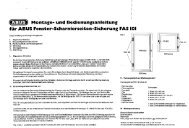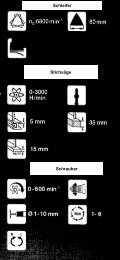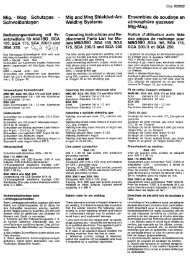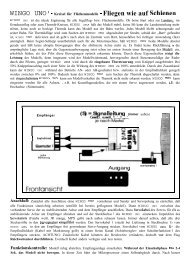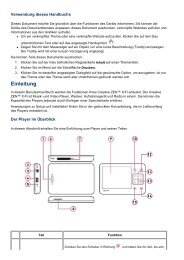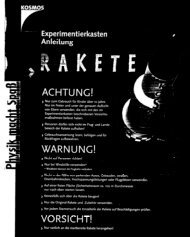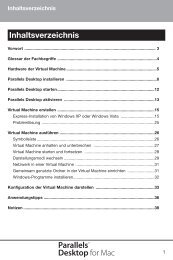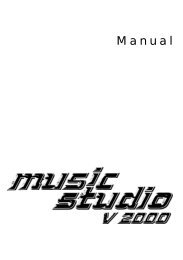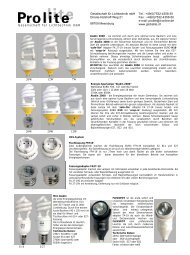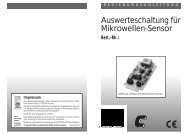bedienungsanleitung - produktinfo.conrad.com
bedienungsanleitung - produktinfo.conrad.com
bedienungsanleitung - produktinfo.conrad.com
You also want an ePaper? Increase the reach of your titles
YUMPU automatically turns print PDFs into web optimized ePapers that Google loves.
%(',(181*6$1/(,781*<br />
86(5 6 0$18$/<br />
02'( ' (03/2,<br />
);<br />
); ),5(<br />
© COPYRIGHT<br />
Nachdruck verboten!<br />
All rights reserved!<br />
Réproduction interdite!<br />
.LOO 0L[HU<br />
��� �������� �������� ������������<br />
���� ���� ������ ��� ������� ������<br />
������ ��� ������������ ���� ��� ������������ �����������
Das vorliegende Produkt ist ein Produkt der OMNITRONIC Showequipment GmbH, GERMANY.<br />
Telefon: 0931/4066788<br />
Telefax: 0931/4066789<br />
Internet: http://www.omnitronic.showtechnic.de<br />
E-Mail: omnitronic@showtechnic.de<br />
This is a product of OMNITRONIC Showequipment GmbH, GERMANY.<br />
Phone no.: 0049-931-4066788<br />
Fax no.: 0049-931-4066789<br />
Internet: http://www.omnitronic.showtechnic.de<br />
E-Mail: omnitronic@showtechnic.de<br />
Ce produit est un produit d’OMNITRONIC Showequipment GmbH, ALLEMAGNE.<br />
No. téléphone: 0049-931-4066788<br />
No. fax: 0049-931-4066789<br />
Internet: http://www.omnitronic.showtechnic.de<br />
E-Mail: omnitronic@showtechnic.de<br />
Weitere Produkte aus dem OMNITRONIC-Sortiment:<br />
Further products of the OMNITRONIC-range:<br />
Autres produits de l'assortiment d'OMNITRONIC:<br />
Article designation No.<br />
OMNITRONIC MIXERS<br />
OMNITRONIC DJ-25 DJ-Battle-Mixer 10006550<br />
OMNITRONIC DJ-25 TECHNO-Edition 10006551<br />
OMNITRONIC DJ-30 DJ-Battle-Mixer 10006555<br />
OMNITRONIC DJ-32 DJ-Battle-Mixer 10006557<br />
OMNITRONIC DJ-32 SPACE-Edition 10006558<br />
OMNITRONIC FX-120 Kill-Mixer 10006602<br />
OMNITRONIC FX-120 Design-Edition 10006603<br />
OMNITRONIC FX-280 Kill-Mixer 10006605<br />
OMNITRONIC FX-280 Kill-Mixer FIRE-Edition 10006606<br />
OMNITRONIC FX-320 Kill-Mixer 10006610<br />
OMNITRONIC FX-320 Kill-Mixer ICE-Edition 10006620<br />
OMNITRONIC FX-740 Kill-Mixer 10006630<br />
OMNITRONIC SM-120 Sound-Mixer 10006700<br />
OMNITRONIC SM-150 Sound-Mixer 10006720<br />
OMNITRONIC SM-240 Sound-Mixer 10006730<br />
OMNITRONIC SM-240 Design-Edition 10006731<br />
OMNITRONIC PM-522 PRO 10006821<br />
OMNITRONIC PM-522 PRO UNIQUE-Edition 10006821<br />
OMNITRONIC PM-640 PRO 10006840<br />
OMNITRONIC PM-640 PRO CHROME-Edition 10006841<br />
OMNITRONIC PM-740 PRO 10006850<br />
OMNITRONIC PM-740 PRO Design-Edition 10006851<br />
OMNITRONIC CM-644 Club-Mixer 10006910<br />
ACCESSORY FOR OMNITRONIC MIXER<br />
OMNITRONIC PEQ-215 Equalizer 2x15-band, 19" 10200035<br />
OMNITRONIC XO-230 Active Crossover, 19" 10304050<br />
OMNITRONIC AN-31, 31-Band Audio Analyzer, 19" 10360300<br />
OMNITRONIC AMPLIFIERS<br />
OMNITRONIC PA-240 Amplifier 2x120W/4Ohms 10450810<br />
OMNITRONIC PA-400 Amplifier 2x200W/4Ohms 10450830<br />
OMNITRONIC PA-1100 Amplifier 2x550W/4Ohms 10450840<br />
OMNITRONIC PA-1600 Amplifier 2x800W/4Ohms 10450850<br />
OMNITRONIC PA-2400 Amplifier 2x1200W/4Ohms 10451000<br />
ACCESSORY FOR RACK-INSTALLATIONS<br />
OMNITRONIC RL-8 Rackbeleuchtung, 19" 10453000
OMNITRONIC CD-PLAYERS<br />
OMNITRONIC CDP-140 Single-CD-Player 10602256<br />
OMNITRONIC CDP-420 Single-CD-Player 10602258<br />
OMNITRONIC CDP-430 Single-CD-Player 10602259<br />
OMNITRONIC CDP-380 Dual-CD-Player 10602263<br />
OMNITRONIC CDP-440 Dual-CD-Player 10602265<br />
OMNITRONIC CDP-450 Dual-CD-Player 10602266<br />
OMNITRONIC CDT-550 Top-Loading CD-Player 10602280<br />
OMNITRONIC CDT-570 Top-Loading CD-Player 10602290<br />
OMNITRONIC TURNTABLES<br />
OMNITRONIC DD-1215 turntable with system 10603027<br />
OMNITRONIC DD-1220 turntable with system 10603030<br />
OMNITRONIC DD-1221 turntable with system 10603031<br />
OMNITRONIC BD-1030 turntable with system 10603035<br />
OMNITRONIC BD-1100 turntable with system 10603040<br />
Pick-up-system OMNITRONIC S-10 10605990<br />
Pick-up-system OMNITRONIC S-15 10606000<br />
Replacement stylus OMNITRONIC S-10 10609045<br />
Replacement stylus OMNITRONIC S-15 10609050<br />
OMNITRONIC DJ-SPEAKERS SERIES<br />
OMNITRONIC D-800 <strong>com</strong>pact sp.-system 90W 11037010<br />
OMNITRONIC D-1000 <strong>com</strong>pact sp.-system 120W 11037020<br />
OMNITRONIC D-1200 <strong>com</strong>pact sp-system 140W 11037030<br />
OMNITRONIC D-1500 <strong>com</strong>pact sp.-system 180W 11037040<br />
OMNITRONIC PRO-SPEAKER-SERIES<br />
OMNITRONIC PRO-1200, 12", 160W 11037520<br />
OMNITRONIC PRO-1500, 15", 200W 11037530<br />
OMNITRONIC PRO-1510, 15", 180W 11037540<br />
OMNITRONIC PRO-1800, 18", 300W 11037550<br />
OMNITRONIC PRO-1810W, 18", 200W, w. crossover 11037560<br />
OMNITRONIC PRO-1810, 18", 200W, w/o crossover 11037561<br />
OMNITRONIC PRO-2500, 2x15", 400 W 11037570<br />
OMNITRONIC MONITOR-SPEAKERS<br />
OMNITRONIC PRO M-1200 speaker, 12", 140 W 11038010<br />
OMNITRONIC ZX-SPEAKERS SERIES<br />
OMNITRONIC ZX-3200, 3-way with 1x12" 11039100<br />
OMNITRONIC ZX-4300, 3-way with 1x15" 11039200<br />
OMNITRONIC ZX-5300, 3-way with 2x15" 11039300<br />
OMNITRONIC ZX-6100W subw. 18" w.crossover 11039400<br />
OMNITRONIC ZX-6100 subw. 18" w/o crossover 11039401<br />
OMNITRONIC HEADPHONES<br />
OMNITRONIC SHP-185; 2-way headphones 14000325<br />
OMNITRONIC SHP-500 XL stereo-headphones 14000390<br />
OMNITRONIC WIRELESS SENDERS/RECEIVERS<br />
OMNITRONIC TD-400, True Diversity 13106650<br />
OMNITRONIC SA-300, wireless sender/receiver 13106700<br />
OMNITRONIC MINI SPEAKER SERIES<br />
OMNITRONIC Control 100, 2-way, 20/60W 11036550<br />
OMNITRONIC Control 200, 2-way, 35/100W 11036560<br />
OMNITRONIC Subwoofer for Control 100/200 11036580
6H "(
6H "( 69B5
6B?>D@1>5
B51B @1>5
BEDIENUNGSANLEITUNG<br />
); ); ),5(<br />
.LOO 0L[HU<br />
Lesen Sie vor der ersten Inbetriebnahme zur eigenen Sicherheit diese Bedienungsanleitung<br />
sorgfältig durch!<br />
Alle Personen, die mit der Aufstellung, Inbetriebnahme, Bedienung, Wartung und Instandhaltung dieses<br />
Gerätes zu tun haben, müssen<br />
- entsprechend qualifiziert sein<br />
- diese Betriebsanleitung genau beachten.<br />
1. EINFÜHRUNG<br />
Wir freuen uns, daß Sie sich für ein OMNITRONIC FX-280 Mischpult entschieden haben. Wenn Sie<br />
nachfolgende Hinweise beachten, sind wir sicher, daß Sie lange Zeit Freude an Ihrem Kauf haben werden.<br />
Nehmen Sie das OMNITRONIC FX-280 aus der Verpackung.<br />
Bitte überprüfen Sie vor der ersten Inbetriebnahme, ob kein offensichtlicher Transportschaden vorliegt.<br />
Sollten Sie Schäden am Stromkabel oder am Gehäuse entdecken, nehmen Sie das Gerät nicht in Betrieb<br />
und setzen sich bitte mit Ihrem Fachhändler in Verbindung.<br />
2. SICHERHEITSHINWEISE<br />
Dieses Gerät hat das Werk in sicherheitstechnisch einwandfreiem Zustand verlassen. Um diesen Zustand zu<br />
erhalten und einen gefahrlosen Betrieb sicherzustellen, muß der Anwender unbedingt die<br />
Sicherheitshinweise und die Warnvermerke beachten, die in dieser Gebrauchsanweisung enthalten sind.<br />
Unbedingt lesen:<br />
Bei Schäden, die durch Nichtbeachtung dieser Bedienungsanleitung verursacht werden, erlischt der<br />
Garantieanspruch. Für daraus resultierende Folgeschäden übernimmt der Hersteller keine Haftung.<br />
Den Netzstecker immer als letztes einstecken. Vergewissern Sie sich, daß der Netzschalter auf „OFF“ steht,<br />
wenn Sie das Gerät ans Netz anschließen.<br />
Halten Sie das Gerät von Hitzequellen wie Heizkörpern oder Heizlüftern fern.<br />
Das Gerät darf nicht in Betrieb genommen werden, nachdem es von einem kalten in einen warmen Raum<br />
gebracht wurde. Das dabei entstehende Kondenswasser kann unter Umständen Ihr Gerät zerstören. Lassen<br />
Sie das Gerät solange uneingeschaltet, bis es Zimmertemperatur erreicht hat!<br />
8
Stellen Sie keine Flüssigkeitsbehälter, die leicht umfallen können, auf dem Gerät oder in dessen Nähe ab.<br />
Falls doch einmal Flüssigkeit in das Geräteinnere gelangen sollte, sofort Netzstecker ziehen. Lassen Sie das<br />
Gerät von einem qualifizierten Servicetechniker prüfen, bevor es erneut benutzt wird. Beschädigungen, die<br />
durch Flüssigkeiten im Gerät hervorgerufen wurden, sind von der Garantie ausgeschlossen.<br />
Lassen Sie das Netzkabel nicht mit anderen Kabeln in Kontakt kommen! Seien Sie vorsichtig beim Umgang<br />
mit Netzkabeln und -anschlüssen. Fassen Sie diese Teile nie mit nassen Händen an!<br />
Vergewissern Sie sich, daß die anzuschließende Netzspannung nicht höher ist als auf dem Spannungswahlschalter<br />
eingestellt. Stecken Sie das Stromkabel nur in geeignete Schukosteckdosen ein.<br />
Bevor das Gerät eingeschaltet wird, müssen alle Fader und Lautstärkeregler auf "0" bzw. auf minimum<br />
gestellt werden.<br />
Beachten Sie bitte, daß Schäden, die durch manuelle Veränderungen an diesem Gerät verursacht werden,<br />
nicht unter den Garantieanspruch fallen.<br />
Kinder und Laien vom Gerät fernhalten!<br />
Im Geräteinneren befinden sich keine zu wartenden Teile. Wartungs- und Servicearbeiten sind<br />
ausschließlich dem autorisierten Fachhandel vorbehalten!<br />
3. BESTIMMUNGSGEMÄSSE VERWENDUNG<br />
Das Gerät kann an jedem beliebigen Ort installiert werden. Achten Sie jedoch darauf, daß das Gerät nicht zu<br />
großer Hitze, Feuchtigkeit und Staub ausgesetzt wird. Vergewissern Sie sich, daß keine Kabel frei<br />
herumliegen. Sie gefährden Ihre eigene und die Sicherheit Dritter!<br />
Betreiben Sie das Gerät nicht in extrem heißen (über 35°C) oder extrem kalten (unter 5°C) Umgebungen.<br />
Halten Sie das Gerät von direkter Sonneneinstrahlung (auch beim Transport in geschlossenen Wägen) und<br />
Heizkörpern fern.<br />
Nehmen Sie das Gerät erst in Betrieb, nachdem Sie sich mit seinen Funktionen vertraut gemacht haben.<br />
Lassen Sie das Gerät nicht von Personen bedienen, die sich nicht mit dem Gerät auskennen. Wenn Geräte<br />
nicht mehr korrekt funktionieren, ist das meist das Ergebnis von unsachgemäßer Bedienung!<br />
Verwenden Sie niemals Reinigungsspray, um die Fader zu reinigen.<br />
Reinigen Sie das Gerät niemals mit Lösungsmitteln oder scharfen Reinigungsmitteln, sondern verwenden<br />
Sie ein weiches und angefeuchtetes Tuch.<br />
Soll das Gerät transportiert werden, verwenden Sie bitte die Originalverpackung, um Transportschäden zu<br />
vermeiden.<br />
Beachten Sie bitte, daß eigenmächtige Veränderungen an dem Gerät aus Sicherheitsgründen verboten sind.<br />
4. ANSCHLÜSSE<br />
• Vergewissern Sie sich, daß der Netzschalter auf OFF steht. Bevor die Verbindungen hergestellt werden<br />
müssen alle Gerät ausgeschalten sein und der Masterregler auf 0 stehen.<br />
• Vergewissern Sie sich bitte, ob der Spannungswahlschalter auf die richtige Stromstärke gestellt ist bevor<br />
Sie das Stromkabel anschließen. Stecken Sie das Stromkabel nur in geeignete Schukosteckdosen ein.<br />
• Um höchste Klangqualität zu erhalten verwenden Sie zum Anschluß Ihres Equipments bitte nur<br />
hochwertige Kabel. Vergewissern Sie sich, daß die Kabel sicher befestigt sind.<br />
• Zum Anschluß Ihres Verstärkers verwenden Sie bitte die MASTER OUT-Buchsen. Vergewissern Sie sich,<br />
daß die Buchsen richtig belegt sind (L & R).<br />
• Wenn Sie eine Aufnahme machen möchten, schließen Sie Ihr Cassettendeck oder Ihr Tonbandgerät bitte<br />
an die REC OUT-Buchsen an. Der REC OUT-Pegel wird vom Masterregler nicht beeinflußt. Das<br />
Ausgangssignal läßt sich über die Kanalfader, die Klangregler und den GAIN-Regler einstellen.<br />
9
• Das FX-280 verfügt über einen Mikrofoneingang. Die Canon Mic 1-Buchse befindet sich auf der Frontplatte<br />
des Gerätes. An diese Buchse lassen sich sowohl Klinken- als auch XLR-Stecker anschließen. Mit dem<br />
TALKOVER-SCHALTER können Sie den Gesamtpegel des Mix reduzieren ohne den Mikrofonpegel zu<br />
verstellen.<br />
• Über den PHONO / AUX-Wahlschalter an der Geräterückseite können Sie festlegen, ob Sie einen<br />
Plattenspieler (PHONO) oder andere Effektgeräte (AUX) an den jeweiligen Kanal anschließen möchten. Bitte<br />
nehmen Sie diese Einstellungen vor, bevor Sie das Mischpult in Ihr Rack einbauen.<br />
• An das FX-280 lassen sich bis zu 2 Plattenspieler über die PHONO 1-Buchsen und PHONO 2-Buchsen<br />
anschließen. Das Plattenspielersignal läßt sich nur dann steuern, wenn die PHONO/LINE-Schalter auf<br />
PHONO gestellt wurde. Der Pegel wird kanalweise über die Fader CH-1 und CH-2 gesteuert.<br />
• Tuner, Cassettendecks, Tonbandgeräte, Videogerät, CD-Player und alle anderen Arten von line/aux<br />
Eingängen können über die LINE-Eingänge auf der Geräterückseite an dieses Mischpult angeschlossen<br />
werden. Die PHONO/LINE-Schalter müssen auf LINE gestellt werden, damit sich die Linesignale steuern<br />
lassen. Der Pegel wird kanalweise gesteuert.<br />
5. FUNKTIONEN:<br />
(1) NETZSCHALTER<br />
(2) MASTER LEVEL / CUE LEVEL DISPLAY<br />
Auf der oberen Anzeige erscheint die Signalstärke des Master-Ausgangssignals der linken bzw. rechten<br />
Seite.<br />
Auf der unteren Anzeige erscheint die Signalstärke des vorgehörten Kanals (CUE-LED leuchtet).<br />
(3) GAIN-REGLER<br />
Mit dem GAIN-Reger können Sie die Signalstärke des Eingangssignales einstellen.<br />
(4) TREBLE-REGLER<br />
Mit dem TREBLE-REGLER können Sie die Höhen des Eingangssignals am jeweiligen Kanal verstärken bzw.<br />
zurücknehmen.<br />
(5) MIDDLE-REGLER<br />
Mit dem MIDDLE-REGLER können Sie die Mitten des Eingangssignals am jeweiligen Kanal verstärken bzw.<br />
zurücknehmen.<br />
(6) BASS-REGLER<br />
Mit dem BASS-REGLER können Sie die Bässe des Eingangssignals am jeweiligen Kanal verstärken bzw.<br />
zurücknehmen.<br />
(7) KILL TASTEN<br />
Über die KILL-TASTEN können Sie den jeweiligen Signalanteil komplett ausschalten.<br />
(8) PHONO/LINE-SCHALTER<br />
Über den PHONO/LINE-SCHALTER wählen Sie die jeweilige Signalquelle.<br />
(9) KANALFADER<br />
Zum Einpegeln des jeweiligen Kanals.<br />
(10) CROSSFADER<br />
Mit dem CROSSFADER wird ein Kanal mit dem anderen gemischt.<br />
(11) MIC 1-BUCHSE<br />
An die Canon Mic 1-Buchse lassen sich sowohl Mikrofone mit 6,3 mm Klinkenstecker als auch mit XLR-<br />
Stecker anschließen. Die Signale lassen sich über den MIC 1-Kanalzug steuern<br />
(12) MIC LEVEL REGLER<br />
Mit dem MIC LEVEL-Regler können Sie den Mikrofonpegel einstellen.<br />
(13) TREBLE-REGLER<br />
Mit dem TREBLE-REGLER können Sie die Höhen des Mikrofonsignals verstärken bzw. zurücknehmen.<br />
(14) MIDDLE-REGLER<br />
Mit dem MIDDLE-REGLER können Sie die Mitten des Mikrofonsignals verstärken bzw. zurücknehmen.<br />
(15) BASS-REGLER<br />
Mit dem BASS-REGLER können Sie die Bässe des Mikrofonsignals verstärken bzw. zurücknehmen.<br />
(16) TALKOVER-SCHALTER<br />
Stellen Sie diesen Schalter auf ON, wenn Sie eine Durchsage machen möchten. Dadurch werden alle<br />
Audiosignale außer dem Mikrofonpegel um 16 dB gesenkt. In der OFF-Position kehren alle Audiosignale zu<br />
ihrem Ausgangspegel zurück.<br />
(17) MASTER REGLER<br />
Mit diesem Regler stellen Sie die Signalstärke des Master-Ausgangssignals ein.<br />
10
(18) CUE MIXING REGLER<br />
Zur Kanalwahl beim Vorhören. Das Vorhörsignal kommt vom Prefader, d.h. die Eingangsfader haben keinen<br />
Einfluß auf das Vorhörsignal.<br />
Schließen Sie Ihren Kopfhörer zum Vorhören an die HEADPHONES-Buchse an. Drehen Sie den CUE<br />
MIXING-REGLER auf CUE und wählen Sie mit dem CUE-Regler den gewünschten Kanal aus.<br />
Wenn Sie den CUE MIXING-Regler auf PGM stellen (CUE-Regler ohne Funktion) können Sie das<br />
Ausgangssignal des Mixers vorhören. Dabei ist es nicht nötig, die Einstellung am MASTER-Regler zu<br />
verändern. Befindet sich der CUE MIXING-Regler in der Mittelstellung, hören Sie sowohl das angewählte<br />
CUE-Signal als auch das Ausgangssignal.<br />
(19) CUE LEVEL REGLER<br />
Mit dem CUE LEVEL-Regler können Sie die Kopfhörerlautstärke einstellen, ohne das gemischte Signal zu<br />
verändern.<br />
(20) HEADPHONES-BUCHSE<br />
An diese Buchse wird der Kopfhörer angeschlossen. Sie können Kopfhörer von 8 bis 600 Ohm verwenden.<br />
Wir empfehlen 16 Ohm.<br />
(21) CUE REGLER<br />
Mit dem CUE-REGLER bestimmen Sie, welcher Kanal vorgehört wird.<br />
6. EIN- UND AUSGÄNGE:<br />
(22) GND (Erdungsklemme)<br />
Zur Vermeidung von Brummen und anderen Störgeräuschen verbinden Sie die Erdungsklemme mit dem<br />
Erdungskabel des Plattenspielers.<br />
(23) PHONO / AUX-UMSCHALTER<br />
Zur Umschaltung der Eingangsbuchsen CH-1 und CH-2 von Aux auf Phono.<br />
(24), (25) LINE / PHONO EINGANGSBUCHSEN<br />
Eingangsbuchsen für Kanäle CH-1 und CH-2.<br />
An die LINE Buchsen können Sie CD-Player und Cassettendecks anschließen.<br />
An die PHONO Buchsen können Sie den/die Plattenspieler anschließen. Verwenden Sie Plattenspieler mit<br />
Magnettonabnehmersystem.<br />
(26) REC OUT<br />
Zum Anschluß Ihres Aufnahmegerätes. Der REC OUT-Pegel wird vom Masterregler nicht beeinflußt.<br />
(27) MASTER OUT<br />
Parallelausgang zum Verstärker. Verbinden Sie hier das Mischpult mit dem Eingang des Verstärkers.<br />
(28) NETZANSCHLUSSBUCHSE MIT SICHERUNGSHALTER<br />
Schließen Sie hier das mitgelieferte Netzkabel an.<br />
(29) SPANNUNGSWAHLSCHALTER<br />
Achten Sie auf die richtige Einstellung.<br />
7. AUSTAUSCHEN DES CROSSFADERS<br />
Gehen Sie wie folgt vor:<br />
• Ziehen Sie den Faderknopf ab<br />
• Entfernen Sie die 2 äußeren Schrauben an der Faderplatte.<br />
• Heben Sie den Fader heraus und ziehen Sie das Anschlußkabel ab.<br />
• Schließen Sie den neuen Fader an und befestigen Sie ihn im Gerät.<br />
11
8. TECHNISCHE DATEN OMNITRONIC FX-280/FX-280 FIRE:<br />
Spannungsversorgung: 110 V/230 V 50/60 Hz<br />
Eingänge: 2 Phono, 2 Aux, 2 Line, 1 Mikro<br />
Mindesteingangsspannung:<br />
Mikrofon: 1,2 mV<br />
Phono: 1 mV<br />
Line: 70 mV<br />
Ausgangsleistung: 20 V Vss (Spitze-Spitze)<br />
Ausgänge: 1 Master-Out, 1 Rec-Out über Cinch-Buchsen<br />
Frequenzgang: 20 - 20 000 Hz, ± 1 dB<br />
Verzerrung: < 0,03 %<br />
Geräuschspannungsabstand: > 85 dB<br />
Talkover-Absenkung: -16 dB<br />
Klangregelung:<br />
Höhen: 15 KHz -60 dB bis +12 dB<br />
Mitten: 1 KHz -30 dB bis +12 dB<br />
Bässe: 50 Hz -60 dB bis +18 dB<br />
Kopfhörerimpedanz: 16 Ohm<br />
Maße: 280 x 368 x 102 mm<br />
Gewicht: 4,2 kg<br />
Bitte beachten Sie: Technische Änderungen bleiben ohne vorherige Ankündigung vorbehalten.<br />
10/98 © Alle Angaben ohne Gewähr!<br />
12
OPERATING INSTRUCTIONS<br />
); ); ),5(<br />
.LOO PL[HU<br />
For your own safety, please read this user manual carefully<br />
before you initial start-up.<br />
All persons involved in the installation, operation and maintenance of this device have to:<br />
- be qualilfied<br />
- follow the instructions of this manual<br />
1. INTRODUCTION<br />
Thank you for having chosen a OMNITRONIC FX-280. If you follow the instructions given in this manual, we<br />
can assure you that you will enjoy this device for many years.<br />
Unpack your OMNITRONIC FX-280.<br />
Please make sure that there are no obvious transport damages. Should you notice any damages on the A/C<br />
connection cable or on the casing, do not take the device into operation and immediately consult your local<br />
dealer.<br />
2. SAFETY INSTRUCTIONS<br />
This device has left our premises in absolutely perfect condition. In order to maintain this condition and to<br />
ensure a safe operation, it is absolutely necessary for the user to follow the safety instructions and warning<br />
notes written in this user manual.<br />
Important:<br />
Damages caused by the disregard of this user manual are not subject to warranty. The dealer will<br />
not accept liability for any resulting defects or problems.<br />
Always plug in the power plug least. Make sure that the Power switch is set to OFF position before you<br />
connect the device to the mains.<br />
Keep away from heaters and other heating sources.!<br />
If the device has been exposed to drastic temperature fluctuation (e.g. after transportation), do not switch it<br />
on immediately. The arising condensation water might damage your device. Leave the device switched off<br />
until it has reached room temperature.<br />
13
Never put any liquids on the device or close to it. Should any liquid enter the device nevertheless, disconnect<br />
from mains immediately. Please let the device be checked by a qualified service technician before you<br />
operate it again. Any damages caused by liquids having entered the device are not subject to warranty!<br />
Never let the AC-cord <strong>com</strong>e into contact with other cables! Handle the AC-cord and all AC-connections with<br />
particular caution!<br />
Make sure that the available voltage is not higher than stated on the AC voltage selector.<br />
Before the device is switched on all faders and volume controls have to be set to 0 or min position.<br />
Please note that damages caused by manual modifications on the device or unauthorized operation by<br />
unqualified persons are not subject to warranty.<br />
Keep away children and amateurs!<br />
There are no servicable parts inside the device. Maintenance and service operations are only to be carried<br />
out by authorized dealers.<br />
3. OPERATING DETERMINATIONS<br />
You can install the device at any desired place. Please make sure that the device is not exposed to extreme<br />
heat, moisture or dust. There should not be any cables lying around. You endanger your own and the safety<br />
of others!<br />
Do not operate the device in extremely hot (more than 30°C) or extremely cold (less than 5°C) surroundings.<br />
Keep away from direct insolation (particularly in cars) and heaters.<br />
Operate the device only after having familiarized with its functions. Do not permit operation by persons not<br />
qualified for operating the device. Most damages are the result of unprofessional operation!<br />
Never use spray cleaners in order to clean the faders!<br />
Never use solvents or aggressive detergents in order to clean the device! Rather use a soft and damp cloth.<br />
Please consider that unauthorized modifications on the device are forbidden due to safety reasons!<br />
4. CONNECTIONS<br />
• Make sure that the power switch is set to OFF. Before you connect the devices, all units have to be<br />
switched off and the master control is set to 0.<br />
• Make sure that the available voltage is not higher than stated on the voltage selector before you connect<br />
the power cord.<br />
• In order to obtain highest sound quality, only use high-quality cables for connecting the devices. Make sure<br />
that the cables are properly fixed.<br />
• Connect your amplifier to the MASTER OUT jacks. Make sure that the jacks are set properly (L & R).<br />
• For recording, connect your tape recorder or cassette deck to the REC OUT jacks. The REC OUT level will<br />
not be influenced by the master control. You can set the output level with the channel faders, the tone<br />
controls and the GAIN control.<br />
• The FX-280 features one microphone input. The Canon Mic 1 jack on the front panel is for ¼" jack plugs<br />
and XLR-plugs. With the TALKOVER-switch, you can attenuate all other signals without affecting the<br />
microphone volume.<br />
• Via the PHONO / AUX-selector on the rearpanel, you can determine whether you want to connect a record<br />
player (PHONO) or other sound-effects (AUX) to the respective channel. Please set the selector before you<br />
install the mixer in your rack.<br />
14
• You can connect up to 2 record players using the PHONO 1 jacks and PHONO 2 jacks on the rearpanel.<br />
You can only control the record player signal after you switched the PHONO/LINE switches to PHONO. The<br />
signal is then controlled via the CH-1 and CH-2 faders.<br />
• Connect your tape recorder, tuner, CD-player, cassette deck or all other line signals to the LINE /AUX jacks<br />
on the rearpanel. You can only control the line signals after you switched the PHONO/LINE switches to line.<br />
The signal is then controlled via the respective faders.<br />
5. FUNCTIONS<br />
(1) POWER SWITCH<br />
(2) MASTER LEVEL / CUE DISPLAY<br />
The upper display shows the level of the left and right master output.<br />
The lower display shows the level of the channel currently being cued (CUE LED on).<br />
(3) GAIN CONTROL<br />
Used to set the level of the input signal.<br />
(4) TREBLE CONTROL<br />
Used to increase or lower the HIs of the input signal.<br />
(5) MIDDLE CONTROL<br />
Used to increase or lower the MIDs of the input signal.<br />
(6) BASS CONTROL<br />
Used to increase or lower the LOWs of the input signal.<br />
(7) KILL BUTTONS<br />
In order to cut the respective signal <strong>com</strong>pletely off.<br />
(8) PHONO/LINE SWITCH<br />
Used to select the input to be sent to the individual channel.<br />
(9) CHANNEL FADER<br />
Used to adjust the level of each channel.<br />
(10) CROSSFADER<br />
Mixes the signals of one channel with another.<br />
(11) MIC 1 JACK<br />
You can connect microphones with ¼ " jack plug or XLR-plug.<br />
(12) MIC LEVEL CONTROL<br />
With the MIC LEVEL control, you can adjust the microphone volume.<br />
(13) TREBLE CONTROL<br />
Used to increase or lower the HIs of the microphone signal.<br />
(14) MIDDLE CONTROL<br />
Used to increase or lower the MIDs of the microphone signal.<br />
(15) BASS CONTROL<br />
Used to increase or lower the LOWs of the microphone signal.<br />
(16) TALKOVER SWITCH<br />
Set this switch to ON if you want to use your microphone. In the ON-position, all signals but the microphone<br />
level are attenuated by 16 dB. In the OFF-position, all signals return to their original level.<br />
(17) MASTER CONTROL<br />
Adjusts the level of the master output.<br />
(18) CUE MIXING CONTROL<br />
Selects the channel for monitoring. The monitor signal <strong>com</strong>es from Prefader. This means it will not be<br />
affected by the channel faders. You can monitor every channel individually and all possible <strong>com</strong>binations.<br />
Connect your headphones to the HEADPHONES jack. Turn the CUE MIXING CONTROL to CUE and select<br />
the desired channels with the CUE control.<br />
When you turn the CUE MIXING CONTROL to PGM (CUE control without function), you can cue the output<br />
signal of the mixer.<br />
If the CUE MIXING CONTROL is set to the center position, you can cue both the channel signal you selected<br />
and the output signal.<br />
(19) CUE LEVEL CONTROL<br />
With the CUE LEVEL control, you can adjust the phones volume without changing the output signal.<br />
(20) HEADPHONES JACK<br />
Use this jack to connect the headphones. Headphones from 8 Ohms to 600 Ohms can be used. 16 Ohms is<br />
re<strong>com</strong>mended.<br />
(21) CUE CONTROL<br />
Use the CUE-control in order to select the channel(s) to be monitored.<br />
15
6. IN- AND OUTPUTS:<br />
(22) GND (Ground terminal)<br />
Connect the ground lead of the turntable with this terminal. This helps to reduce humming and pop noises.<br />
(23) PHONO / AUX SELECTOR<br />
Used to switch the input jacks of CH-1 and CH-2 to aux or phono.<br />
(24), (25) LINE / PHONO INPUT JACKS<br />
Input jack for CH-1 and CH-2. Connect turntables equipped with MM pickup cartridge to PHONO input. CD<br />
players or Tape Decks should be connected to LINE input. Line level musical instruments with stereo outputs<br />
such as Rhythm Machines or Samplers should also be connected to LINE inputs.<br />
(26) REC OUT<br />
To connect your record unit.<br />
(27) MASTER OUT<br />
Parallel output of P.A. output. Connect with the input of power amplifier.<br />
(28) AC CONNECTION AND FUSEHOLDER<br />
(29) AC VOLTAGE SELECTOR<br />
Make sure that the selector is properly set.<br />
7. REPLACING THE CROSSFADER<br />
Instructions for replacing the crossfader:<br />
• Remove the fader knob.<br />
• Remove the two outer screws on the fader panel.<br />
• Take the fader out and unplug the connection cable.<br />
• Connect the new fader and fix it in the device.<br />
8. TECHNICAL SPECIFICATIONS OMNITRONIC FX-280/FX-280 FIRE:<br />
Power supply: 110 V/230 V 50/60 Hz<br />
Inputs: 2 phono, 2 line, 2 aux, 1 mic<br />
Minimum input voltage:<br />
Microphone: 1.2 mV<br />
Phono: 1 mV<br />
Line: 70 mV<br />
Output power: 20 V peak to peak<br />
Outputs: 1 Master-Out, 1 Rec-Out via RCA<br />
Frequency range: 20 - 20,000 Hz, ± 1 dB<br />
Distortion: < 0.03 %<br />
S/N-ratio: > 85 dB<br />
Talkover-attenuation: -16 dB<br />
Tone control:<br />
Treble: 15 Khz -60 dB to +12 dB<br />
Middle: 1 KHz -30 dB to +12 dB<br />
Bass: 50 Hz -60 dB to +18 dB<br />
Headphones impedance: 16 Ohms<br />
Dimensions: 280 x 368 x 102 mm<br />
Weight: 4.2 kg<br />
Please note: All specifications are subject to change withour prior notice.<br />
10/98 © Errors and omissions excepted.<br />
16
MODE D'EMPLOI<br />
); ); ),5(<br />
7DEOH GH PL[DJH<br />
Pour votre propre sécurité, veuillez lire ce mode d'emploi avec attention avant la première mise en<br />
service.<br />
Toute personne ayant à faire avec le montage, la mise en marche, le maniement et l’entretien de cet<br />
appareil<br />
- doit être suffisamment qualifiée<br />
- est priée de suivre strictement les instructions de service suivantes.<br />
1. INTRODUCTION<br />
Nous vous remercions d'avoir choisi un OMNITRONIC FX-280. Si vous respectez les instructions de service<br />
suivantes, vous allez profiter longtemps de votre achat.<br />
Sortez le OMNITRONIC FX-280 de son emballage.<br />
Avant tout, assurez-vous que l'appareil n'a pas subi de dommages lors de son transport. Si tel était le cas,<br />
contactez immédiatement votre revendeur.<br />
2. INSTRUCTIONS DE SÉCURITÉ<br />
Cet appareil a quitté les ateliers dans un état irréprochable. Pour assurer un bon fonctionnement, sans<br />
danger, l'utilisateur doit suivre les instructions contenues dans ce mode d'emploi.<br />
Attention:<br />
Tout dommage occasionné par la non observation des instructions de montage ou d'utilisation n'est<br />
pas couvert par la garantie.<br />
La prise au secteur doit toujours être branchée en dernier lieu. Assurez-vous que l'interrupteur "ON-OFF" de<br />
l'appareil est en position "OFF" avant d'effectuer ce branchement.<br />
Tenez l'appareil éloigné de toute source de chaleur.<br />
17
Lorsque l'appareil est transporté d'un endroit froid à un endroit chaud, il se forme de la condensation<br />
susceptible d'endommager les modules électroniques. Ne pas brancher l'appareil avant qu'il ait atteint la<br />
température ambiante.<br />
Ne déposez jamais de récipient contenant un liquide sur le dessus de l'appareil ou à proximité immédiate de<br />
celui-ci. Si toutefois, du liquide devait s'infiltrer dans l'appareil, le débrancher immédiatement, puis le faire<br />
vérifier par un technicien <strong>com</strong>pétent avant de le réutiliser. Les dommages causés par l'infiltration de liquides<br />
ne sont pas couverts par la garantie.<br />
Ne laissez pas les câbles d'alimentation en contact avec d'autres câbles. Soyez prudent; lorsque vous<br />
manipulez les câbles et les connexions, vous êtes soumis à des risques d'électrocutions! Ne manipulez<br />
jamais les parties sous tension avec les mains mouillées!<br />
Assurez-vous que la tension électrique ne soit pas supérieure à celle indiquée sur le sélecteur de tension au<br />
dos de l’appareil. Mettez le câble d'alimentation seulement dans des prises adaptées.<br />
Avant d'allumer l'appareil, assurez-vous que tous les faders et tous les régulateurs de volume sont mis à "0"<br />
ou bien au minimum.<br />
Tout dommage résultant d'une modification sur l'appareil n'est pas couvert par la garantie.<br />
Tenir les enfants et les novices éloignées de l'appareil.<br />
L'intérieur de l'appareil ne contient pas de parties nécéssitant un entretien. L'entretien et les réparations<br />
doivent être effectuées par un technicien <strong>com</strong>pétent!<br />
3. EMPLOI SELON LES PRESCRIPTIONS<br />
L'appareil peut être installé à l'endroit de votre choix. Evitez toutefois les endroits humides, poussiéreux ou<br />
trop chauds. Assurez-vous que les câbles ne trainent pas au sol. Il en va de votre propre sécurité et de celle<br />
d'autrui.<br />
Ne pas utiliser l'appareil lorsque la température ambiante est supérieure à 35°C ou inférieure à 5°C. Ne pas<br />
exposer l'appareil directement aux rayons solaires (lors d'un transport dans un véhicule fermé par exemple).<br />
N'utilisez l'appareil qu'après avoir pris conaissance de ses fonctions et possibilités. Ne laissez pas des<br />
personnes in<strong>com</strong>pétentes utiliser cet appareil. La plupart des pannes survenant sur cet appareil sont dues à<br />
une utilisation inappropriée par des personnes in<strong>com</strong>pétentes.<br />
N'utilisez jamais de spray de nettoyage pour nettoyer les faders.<br />
Ne nettoyez pas l'appareil avec des produits de nettoyages trop puissants ou abrasifs. Utilisez un chiffon<br />
doux, humide.<br />
Si vous deviez transporter l'appareil, utilisez l'emballage d'origine pour éviter tout dommage.<br />
Notez que pour des raisons de sécurité, il est interdit d'entreprendre toutes modifications sur l'appareil.<br />
4. CONNEXIONS<br />
• Assurez-vous que l'interrupteur "ON-OFF" de l'appareil est en position "OFF". Avant d'effectuer le<br />
branchement tous les appareils doivent être éteints et le régulateur master doit être mis au 0.<br />
• Assurez-vous que la tension électrique ne soit pas supérieure à celle indiquée sur le sélecteur de tension<br />
au dos de l’appareil. Mettez le câble d'alimentation seulement dans des prises adaptées.<br />
• Pour réussir à une haute qualité de son branchez votre equipement qu'avec des câbles de haute valeur.<br />
Assurez-vous que les câbles sont bien fixés.<br />
18
• Entreprenez le raccord de votre amplificateur avec les douilles MASTER OUT. Faites attention que les<br />
canaux sont assurés correctement (L = gauche; R = droite).<br />
• Si vous désirez effectuer un enregistrement, connectez votre platine à cassette ou votre magnétophone<br />
aux douilles REC OUT. Le régulateur MASTER n'influence pas les niveaux REC OUT. Vous pouvez<br />
contrôler le niveau REC OUT avec les faders CHANNEL, les régulateurs du son et le régulateur GAIN.<br />
• Le FX-280 dispose d’une entrée de micro. La douille MIC 1 se trouve à la platine avant et accepte des<br />
microphones avec jack 6,3 mm ou jack XLR. Avec le bouton TALKOVER, vous pouvez réduire les<br />
niveaux entrées sauf le niveau MIC de moins de 16 dB.<br />
• Avec les sélecteurs PHONO / AUX au dos de l'appareil, vous pouvez choisir si vous voulez connecter<br />
une platine disque (PHONO) ou autres effets sonores (AUX) au canal désiré. S.v.p. ajuster la sélection<br />
désirée avant d'installer le pupitre de mixage au rack.<br />
• Vous pouvez connecter jusqu'à trois platines disques à la douille PHONO 1 et PHONO 2 se trouvent au<br />
dos de l'appareil. Le signal de la platine disque ne se laisse que contrôler si le sélecteur PHONO/LINE<br />
est mis à PHONO. Le niveau est contrôlé par canal sur les faders CH-1 et CH-2.<br />
• Connectez les syntonisateurs, les platines à cassette, les vidéos, les lecteurs de disque audionumérique<br />
et toute autre sorte de signal LINE à la table de mixage sur les entrées LINE au dos de l'appareil. Le<br />
sélecteur PHONO/LINE doivent être mis à LINE pour que les signaux LINE se laissent contrôler. Le<br />
niveau est contrôlé par canal sur les faders respectifs.<br />
5. FONCTIONS<br />
(1) INTERRUPTEUR ON/OFF (POWER)<br />
(2) L’AFFICHAGE MASTER LEVEL / CUE<br />
L’affichage supérieur indique le niveau de la douille master à la gauche et à la droite.<br />
L’affichage en bas indique le niveau des canaux préecoutés (indicateur CUE allumé).<br />
(3) RÉGULATEUR GAIN<br />
Pour régler le niveau d’entrée.<br />
(4) RÉGULATEUR TREBLE<br />
Pour élever ou réduire les aigues.<br />
(5) RÉGULATEUR MIDDLE<br />
Pour élever ou réduire les médianes.<br />
(6) RÉGULATEUR BASS<br />
Pour élever ou réduire les basses.<br />
(7) INTERRUPTEURS KILL<br />
Pour annuler le signal réspectif.<br />
(8) SÉLECTEUR PHONO/LINE<br />
Canaux 1 et 2 sont <strong>com</strong>mutables phono/aux/line.<br />
(9) FADERS CANAUX<br />
Pour niveler le niveau d’entrée de chaque canal.<br />
(10) CROSSFADER<br />
Pour mixer un canal avec l’autre.<br />
(11) DOUILLE MIC 1<br />
Vous pouvez connecter des microphones avec Jack 6,35 mm ou XLR.<br />
(12) RÉGULATEUR MIC LEVEL<br />
Le régulateur MIC LEVEL vous permet de régler l'intensité sonore du microphone.<br />
(13) RÉGULATEUR TREBLE<br />
Pour élever ou réduire les aigues.<br />
(14) RÉGULATEUR MIDDLE<br />
Pour élever ou réduire les médianes.<br />
(15) RÉGULATEUR BASS<br />
Pour élever ou réduire les basses.<br />
(16) INTERRUPTEUR TALKOVER<br />
Mettez cet interrupteur à ON pour faire un message publicitaire: Tous les signaux audio vont être accentués<br />
19
de 16 dB à part le niveau du micro. En position OFF tous les signaux audio reviennent à leur niveaux<br />
d'origine.<br />
(17) RÉGULATEUR MASTER<br />
Règle le niveau du signal MASTER.<br />
(18) SÉLECTEUR CUE MIXING<br />
Pour choisir le canal lors de la préécoute. Le signal de préécoute vient du prefader, c'est-à-dire que les<br />
entrées de fader ne l'influence pas.<br />
Branchez le casque d'écoute pour préécouter à la douille HEADPHONES. Tournez le sélecteur CUE<br />
MIXING à CUE et choisissez le canal désiré à l'aide des régulateur CUE.<br />
Si vous mettez le sélecteur CUE MIXING à PGM (régulateur CUE sans fonction), vous pouvez préécouter le<br />
signal de sortie de la table de mixage. Il n'est pas nécessaire de modifier le réglage au régulateur master. Si<br />
le sélecteur CUE MIXING se trouve à la position au milieu, vous écoutez le signal CUE choisi et également<br />
le signal de sortie.<br />
(19) RÉGULATEUR CUE LEVEL<br />
Le régulateur CUE LEVEL vous permet de régler l'intensité sonore du casque d'écoute sans modifier le<br />
signal mixé.<br />
(20) PRISE HEADPHONES (CASQUE D'ECOUTE)<br />
Brancher ici la fiche d'un casque dont l'impédance va de 8 à 600 Ω. Nous vous re<strong>com</strong>mandons d’utiliser des<br />
casques avec 16 Ω.<br />
(21) REGULATUER CUE<br />
Avec le régulateur CUE vous pouvez choisir les canaux à préécouter.<br />
6. ENTRÉES ET SORTIES<br />
(22) BORNE GND<br />
Brancher le fil de mise à la terre à la borne GND. Le fait de raccorder le fil de masse réduit le ronronnement.<br />
(23) SÉLECTEUR PHONO / AUX<br />
Pour <strong>com</strong>muter les douilles entrées de CH-1 et CH-2 à AUX ou PHONO.<br />
(24), (25) ENTRÉES LINE/ PHONO<br />
Prise d'entrée pour les canaux CH-1 et CH-2. Raccordez le lecteur de disque audionumérique et la platine à<br />
cassette aux prises LINE. Connectez aux prises PHONO la platine disque. Utilisez des platines disques avec<br />
des cellules MM.<br />
(26) REC OUT<br />
Connectez votre appareil d'enregistrement ici. Le niveau de REC OUT n'est pas contrôlé avec le régulateur<br />
MASTER.<br />
(27) MASTER OUT<br />
Pour connecter l’amplificateur principal.<br />
(28) CONNEXION DE TENSION ET PORTE-FUSIBLE<br />
(29) SÉLECTEUR DE TENSION<br />
Assurez-vous que ce sélecteur est mis à la position correcte.<br />
7. REMPLACEMENT DU CROSSFADER<br />
Procédez de la manière suivante:<br />
• Retirez la tête du fader.<br />
• Retirez les deux vis extérieurs à la plaque du fader.<br />
• Retirez maintenant le fader et débranchez.<br />
• Connectez le fader de rechange et fixez-le à la table de mixage.<br />
20
9. CARACTÉRISTIQUES TECHNIQUES OMNITRONIC FX-280/FX-280 FIRE:<br />
Alimentation: 115/230 V, 50/60 Hz<br />
Entrées: 2 phono, 2 line, 2 aux, 1 mic<br />
Voltage minimum d'entrée:<br />
Microphone: 1,2 mV<br />
Phono: 1 mV<br />
Line: 70 mV<br />
Puissance sortie: 20 V Vss<br />
Sorties: 1 Master-Out, 1 Rec-Out 1 Booth-Out via cinch<br />
Réponse des fréquences: 20 - 20 000 Hz, ± 1 dB<br />
Distorsion: < 0,03 %<br />
Rapport S/N: > 85 dB<br />
Atténuation talkover: -16 dB<br />
Réglage du son:<br />
Aiguës: 15 KHz -60 dB à +12 dB<br />
Médiums: 1 KHz -30 dB à +12 dB<br />
Graves: 50 Hz -60 dB à +18 dB<br />
Impedance du casque d'écoute: 16 Ohm<br />
Dimensions: 280 x 368 x 102 mm<br />
Poids: 4,2 kg<br />
Attention! Les caractéristiques techniques sont susceptibles d’être modifiées sans préavis.<br />
10/98 © Caractéristiques techniques sous réserves d’erreurs au de fautes de frappes.<br />
21



